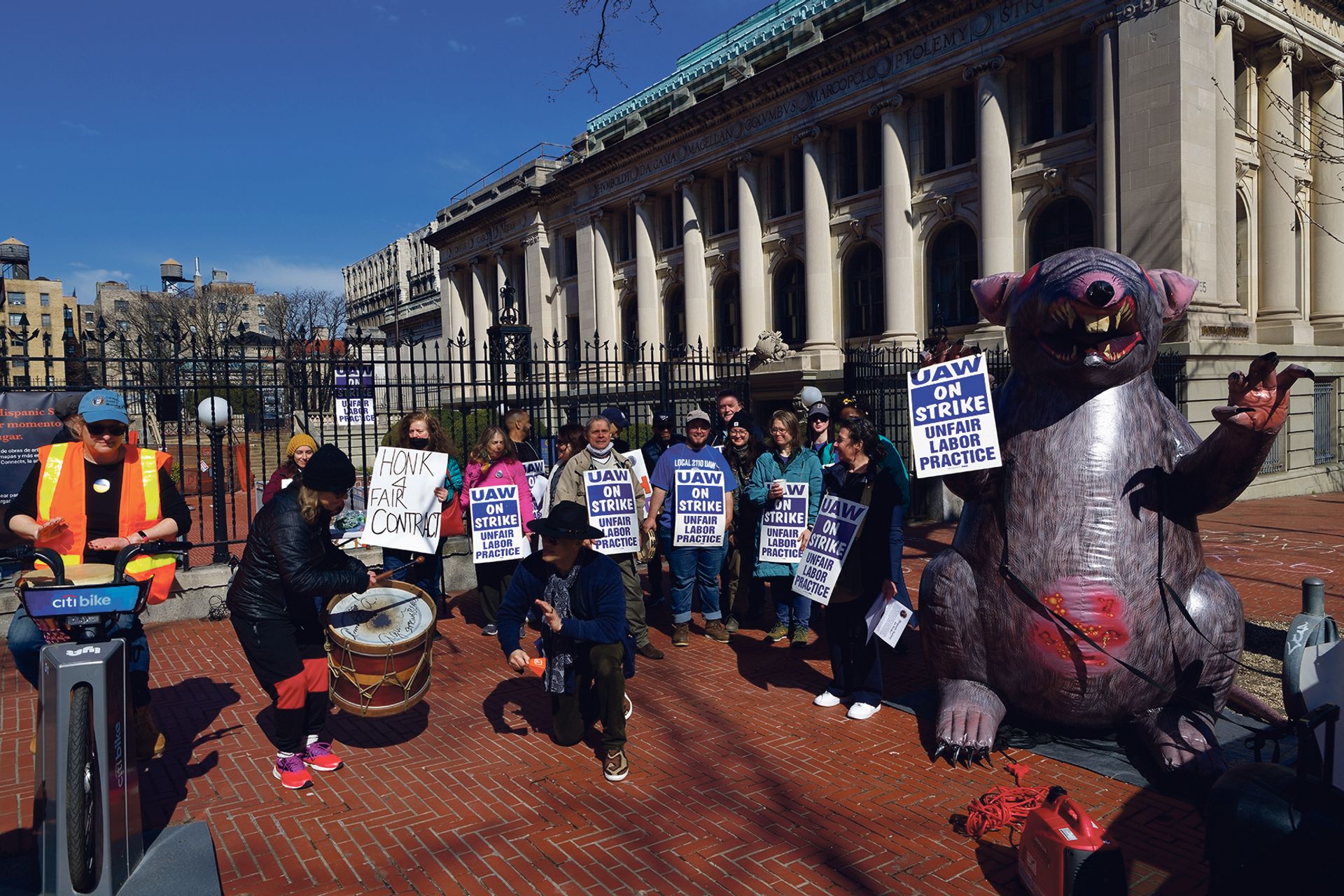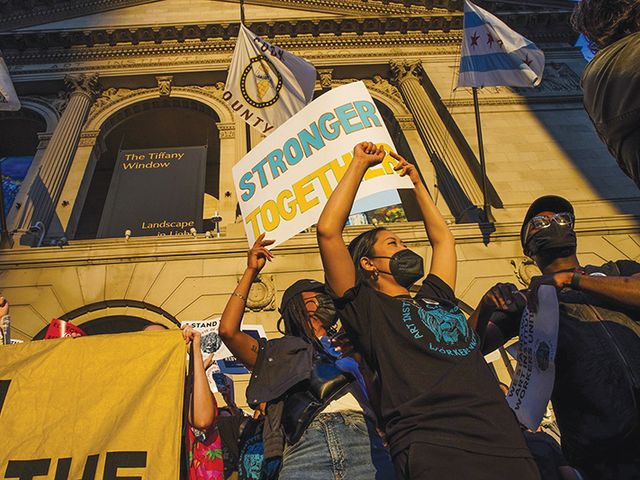Over the course of the past two months workers at the Hispanic Society Museum & Library—a jewel box institution in New York's Washington Heights devoted to the art of Spain, Portugal and former Latin American colonies—have been on strike. It is the first strike of this magnitude at a New York museum in more than 20 years, since unionised employees at the Museum of Modern Art walked off the job in 2000 for 134 days.
Museum administrators “have everything to lose by the continuation of strike. It makes no sense other than pure stubbornness and intransigence,” says Maida Rosenstein, the director for organising with United Auto Workers (UAW) Local 2110, which represents staff at the Hispanic Society and many other art institutions throughout the north-east. “It’s a very, very particular collection, with people who have incredible expertise in this area.” The museum had been due to reopen in early April following a six-year renovation—that reopening has now been postponed indefinitely.
In July 2021, Hispanic Society workers voted 15-1 to form a union, which has since been negotiating their first contract. However, a contentious situation has subsequently played out between staff and the museum administration.
Overwhelming support for strike
In February 2023, the employees sent an open letter to the museum’s board of trustees outlining staffing shortages that, they claimed, made it difficult to properly maintain and safeguard the collection, and raising concerns about recent administrative appointments, among other issues. After minimal progress in negotiations, 78% of union members voted to authorise a strike.
In a statement, the Hispanic Society’s administrators say they remain “optimistic that an agreement will be reached in the near future, and we are committed to keeping an open line of communication with our devoted staff”. A spokesperson adds that the administrators’ most recent proposal “is very competitive in the New York museum landscape, even compared to much wealthier cultural organisations”.

The strike at the Hispanic Society Museum & Library is now the longest at a New York art museum since a four-month walkout at MoMA in 2020
Photo courtesy UAW Local 2110
At the heart of the negotiations are pay and healthcare. In one of the most recent offers the museum made to unionised workers, staff would have to pay their own healthcare premiums and deductibles. Wages would increase but, according to union members, not by enough to cover the additional healthcare expenses. Negotiations are at an impasse, and the strike has the potential to become the longest at a US museum in more than a generation. Already it has eclipsed the most high-profile recent museum strike.
That dates back to last autumn when the union representing 180 employees of the Philadelphia Museum of Art (PMA)—part of the American Federation of State, County and Municipal Employees (AFSCME)—voted to authorise a strike. Two years after the PMA branch of AFSCME had been formed, staff and museum administrators had still not been able to agree on their first contract—a process that typically takes around 15 months.
Negotiations at the PMA centred on wages, paid family leave and working conditions but unfolded amid several scandals and administrative shake-ups at the museum, whose director of 13 years, Timothy Rub, announced in summer 2021 that he would be stepping down. There have also been allegations of sexual harassment and physical and verbal abuse against managers at the institution, which in 2021 completed a $232m campus expansion and integration project designed by Frank Gehry. Last summer, the museum’s unionised workers filed eight charges of unfair labour practices with the National Labor Relations Board, accusing administrators of “repeatedly interfering with employees’ rights”.
Agreement
Rub’s successor, the former National Gallery of Canada director Sasha Suda, started in her new role on the first day of the strike. The union’s efforts garnered national attention, and the museum came under fire for hiring non-union employees to install a blockbuster Henri Matisse exhibition. On 16 October, after 19 days on strike, union members ratified a two-year deal that includes a wage increase of 14% over the contract period, reduced healthcare costs, four weeks of paternity leave and a hike in the minimum hourly wage at the museum to $16.75.
Shortly after workers at the PMA ratified their first contract, staff at the Storm King Art Center in the Hudson River Valley announced their intention to form a union. Workers hoped the popular sculpture park’s administration would voluntarily recognise the union, but it did not. On 27 April, following an election with the National Labor Relations Board, the workers joined the Civil Service Employees Association, which is affiliated to the AFSCME.
“I’m always thinking of the future of Storm King and their statement supporting inclusion, diversity, equity and accessibility,” says Rebecca Lujan, an education co-ordinator at the centre and a member of the organising committee. “If it’s our practice that we want a more inclusive space at Storm King, it has to happen internally with a union inclusive of all workers.”
National movement
Organising efforts at Storm King, the PMA, the Hispanic Society and elsewhere reflect a trend that has been growing in the US art and heritage sector over the course of the past five years and accelerated with the onset of the Covid-19 pandemic. Workers at more than 20 institutions have formed a union since 2020 or are actively in negotiations for their first contract, including the Jewish Museum and the Solomon R. Guggenheim Museum in New York, the Museum of Fine Arts in Boston, and Mass Moca in Massachusetts. In March, after 16 months of negotiations, workers at the Whitney Museum of American Art, who had formed a union in spring 2021, ratified their first contract.
The issues prompting workers to form unions across the country and across a broad range of industry sectors are remarkably consistent: wages, benefits and working conditions. According to the US Bureau of Labor Statistics, the number of wage and salary workers who belonged to a union in 2022 was 14.3 million, a 1.9% increase on 2021.
“It’s not surprising at all given what it’s like to work within the non-profit museums sector”
“It’s a steady drip of museums around the country announcing their intent to organise, which is really exciting and not surprising at all given what it’s like to work within the non-profit museums sector,” says Adam Rizzo, an educator at the PMA and president of the museum’s AFSCME union.
The union movement at museums has coincided with a broader push to organise workplaces across the US economy, from Amazon and Starbucks to HarperCollins. University workers, more and more of whom are subject to the precarious employment conditions of the gig economy, are organising in droves—from the University of California system to the New School in New York, and Rutgers University in New Jersey. While, for the first time in 15 years, the 11,000 members of the Writers Guild of America are on strike amid stalled negotiations with Hollywood film studios.
Not a silver bullet
“We were able to make some really significant changes by going on strike and winning the contract we ended up with, but there’s still a lot of work to be done,” says Rizzo. Gains made in the union’s new contract “will help ultimately create a more equitable workplace and hopefully provide living wages that would support a more diverse and equitable workplace”. But, he warns: “A union contract is not a silver bullet to fix everything.”
For many museum workers, forming a union is just part of an effort to change institutional culture from the inside out—correcting decades of hiring and collecting practices that have tended to disproportionately put white men in positions of power and white male artists’ work in the galleries.




